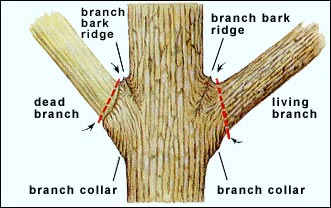|
************************************************************* PRUNING BY ·
Prune dead wood
any time but make sure the branch or limb is dead. Just because the
leaves or needles turn brown does not necessarily mean that the branch
is dead. ·
Do not make a
flush cut when trimming a shrub or tree. Cut just outside the branch
collar which is a swelling where the branch comes from the main trunk or
branch. See illustration below
Illustration
is reprinted by permission from USDA Forest
Service Publication #NA-FR-01-98, page #6. Illustration is by ·
After pruning,
do not apply tree paint, wound dressing, or tar. Research has found that
a tree heals better without them. ·
Pruning on
trees and shrubs promotes new growth from where you cut. Therefore, do
not prune from mid-August to the time of a hard freeze as the
new growth from pruning will usually not mature by the time we have a
couple hard freezes. Immature new growth will not survive a normal
winter in Southeast and South Central Nebraska. ·
prune
most trees after a couple of hard freezes and the tree is dormant.
Actually the best time to prune most trees and shrubs is in late
February or early March just before new growth starts.
This way the open wound is not subject to a long period of cold
weather. ·
The best time
to prune fruit trees is also in late February or early March while
dormant. Removal of some of the sucker growth can be done any time. ·
DO
NOT PRUNE most
trees and shrubs between mid-April and the end of May which is the peak
growth time. ·
DO
NOT PRUNE OAK TREES
between February 1st and Halloween when the beetle that
carries a disease called Oak Wilt is most active. Open wounds on Oak
trees is a prime target for this beetle. Prune Oak trees in the winter
when the tree is dormant. ·
Do
NOT PRUNE ELM TREES between
April 1st and August 31st when the Elm Bark Beetle
is most active. ·
In general
those trees and shrubs that bloom in the spring on one year old wood
should be pruned within 3 to 4 weeks after flower petal drop. This
includes old
fashioned FRENCH lilac,
forsythia, BRIDAL WREATH SPIREA, and FLOWERING ALMOND.
Pruning at any other time will remove next year’s flower buds. ·
MAGNOLIA do not like to be pruned unless necessary to remove dead
branches or for minor shaping. Prune right after bloom. A
special thank you to Copyright 2010 *********************************************************** TIME
TO RESEED YOUR LAWN BY
If
crabgrass took over your lawn, or you had an infestation of grubs, or
fungus wiped out spots in your yard, the best time to reseed is in the
fall and primarily between August 15th and October 1st.
Planting this time of year the grass will germinate faster in the warm
soil than in spring, you will have less competition from weed seeds, and
the new grass should mature before our harsh cold winter. If you wait
too long in the fall to reseed, the new little seedlings may winter
kill. This
is also a good time to core aerate your lawn. Water your lawn a couple
days before aeration. Aerate after applying a starter fertilizer and
grass seed. Your fertilizer and grass seed will be deposited at just the
right depth and have good contact with soil by applying before aeration.
Start
watering. The worst thing that can happen to new seed is to let it dry
out before it germinates. The grass seed needs to keep damp but not
soggy. In August and early September you will have to water at least
once per day and on real warm days twice a day. To help keep the seed
from drying out you can use a mulch mat, straw, or straw substitute made
from ground-up newspapers (green or blue pellets) as mulch. The pellets
swell when watered and since they are organic like the straw, they will
decompose on their own and add organic matter to your soil. DO NOT BUY CHEAP SEED!!! Buy the best seed you can find that is
blended for our Midwestern soil and weather. Use a blend of disease
resistance grass. Your lawn will never Copyright 2010 |
